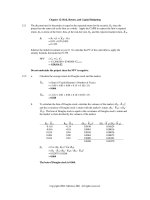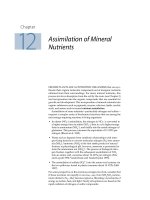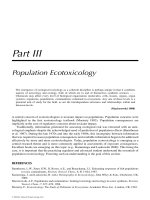Multicultural chapter 12
Bạn đang xem bản rút gọn của tài liệu. Xem và tải ngay bản đầy đủ của tài liệu tại đây (139.66 KB, 26 trang )
CHAPTER 12
WHITE RACIAL IDENTITY
DEVELOPMENT:
THERAPEUTIC
IMPLICATIONS
The Invisible Whiteness of Being
Whiteness is transparent precisely because of its
everyday occurrence—its institutionalized
normative features in our culture—and because
Whites are taught to think of their lives as
morally neutral, average, and ideal.
Many Whites become defensive when labeled as
White because they do not want to accept White
privilege.
Understanding the Dynamics
of Whiteness
Most White folks perceive themselves as unbiased
individuals who do not harbor racist thoughts and
feelings, so to admit to being racist, sexist, or
homophobic requires people to recognize that the selfimages that they hold so dear are based on false notions
of the self.
White helping professionals must free themselves from
the cultural conditioning of their past and move toward
the development of a antiracist White identity.
Understanding the Dynamics
of Whiteness
White counselors and therapists may be:
unintentional racists;
unaware of their biases, prejudices, and discriminatory
behaviors;
often perceiving themselves as moral, good, and decent
human beings and find it difficult to see themselves as
racist;
without a sense of what their Whiteness means to them; and
using therapeutic approaches to multicultural populations
that are likely to be more harmful (unintentionally) than
helpful.
White Racial Identity Development
—Descriptive Model
Phase One – Naïveté
Early childhood marked by naïve curiosity about race.
Tendency to be innocent, open, and spontaneous regarding
racial differences.
May notice differences, but awareness of social meaning is
absent or minimal.
Racial awareness and the burgeoning social meanings occur
between the ages of 3 and 5 years.
White Racial Identity Development
—Descriptive Model
Phase Two–Conformity
Characteristics of naïveté may be maintained.
Minimal awareness of self as a racial/cultural being.
Strong belief in the universality of values and norms
governing behavior.
Unlikely to recognize the polarities of democratic principles
of equality and the unequal treatment of minority groups.
White Racial Identity Development
—Descriptive Model
Phase Two–Conformity
Compartmentalization of contradictory attitudes,
beliefs, and behaviors (i.e., can believe people are
people, but treats minorities differently).
Because of naïveté and encapsulation, it is possible
for two diametrically opposed belief systems to
coexist in your mind.
White Racial Identity Development
—Descriptive Model
Phase Two–Conformity
Uncritical acceptance of White supremacist notions
that relegate minorities into the inferior category
with all the racial stereotypes.
Belief that racial and cultural differences are
considered unimportant. This allows Whites to
avoid perceiving themselves as “dominant” group
members, or of having biases and prejudices.
White Racial Identity Development
—Descriptive Model
Phase Two – Conformity
The primary mechanism used in encapsulation is
denial: denial that people are different, denial that
discrimination exists, and denial of your own
prejudices. Instead, the locus of the problem is seen
to reside in the minority individual or group.
In her own White racial awakening, Peggy
McIntosh (1989) stated:
White Racial Identity Development
—Descriptive Model
Phase Two–Conformity
“My schooling gave me no training in seeing myself as an
oppressor, as an unfairly advantaged person, or as a
participant in a damaged culture. I was taught to see myself
as an individual whose moral state depended on her
individual moral will...Whites are taught to think of their
lives as morally neutral, normative, and average, and also
ideal, so that when we work to benefit others, this is seen as
work which will allow ‘them’ to be more like ‘us.’”
Whereas the Naïveté stage is brief in duration, the
Conformity stage can last a lifetime.
White Racial Identity Development
—Descriptive Model
Phase Three–Dissonance
Obliviousness breaks down when Whites become aware of
inconsistencies.
Becoming conflicted over irresolvable racial moral dilemmas that
are frequently perceived as polar opposites: believing they are
nonracist, yet not wanting their son or daughter to marry a
minority group member.
Belief that “all men are created equal,” yet seeing society treat
people of color as second class citizens; and not acknowledging
that oppression exists, yet witnessing it (beating of Rodney King
and the unwarranted persecution of Wen Ho Lee).
White Racial Identity Development
—Descriptive Model
Phase Three–Dissonance
People become increasingly conscious of whiteness
and may experience dissonance, resulting in
feelings of guilt, depression, helplessness or
anxiety.
Movement into the Dissonance phase occurs when
Whites are forced to deal with the inconsistencies
that have been compartmentalized or they
encounter information/experiences at odds with
their denial.
White Racial Identity Development
—Descriptive Model
Phase Three-Dissonance
Dissonance may make Whites feel guilty, shameful, angry,
and depressed. Rationalizations may become the manner
used to exonerate their inactivity in combating perceived
injustice or personal feelings of prejudice: “I’m only one
person-what can I do?” or “Everyone is prejudiced, even
minorities.”
As these conflicts ensue, Whites may retreat into the
protective confines of White culture (encapsulation of the
previous stage) or move progressively toward insight and
revelation (resistance and immersion stage).
White Racial Identity Development
—Descriptive Model
Phase Four-Resistance and Immersion
Whites begin to question and challenge their racism. For the
first time, they begin to realize what racism is all about, and
their eyes are suddenly opened.
Racism becomes noticeable in all facets of their daily lives
(advertising, television, educational materials, interpersonal
interactions, etc.). A major questioning of their racism and
that of others mark this phase of development. In addition,
increasing awareness of how racism operates and its
pervasiveness in U.S. culture and institutions is the major
hallmark at this level of development.
White Racial Identity Development
—Descriptive Model
Phase Four–Resistance and Immersion
Likely to experience considerable anger at family
and friends, institutions, and larger societal values
that are seen as having sold them a false bill of
goods (democratic ideals) that were never
practiced.
Guilt is also felt for having been a part of the
oppressive system.
White Racial Identity Development
—Descriptive Model
Phase Four–Resistance and Immersion
The "White liberal" syndrome may develop and be
manifested in two complementary styles: (a) the
paternalistic protector role or (b) an over identification with
the minority group. In the former, Whites may devote
energies in an almost paternalistic attempt to protect
minorities from abuse.
May actually even want to identify with a particular
minority group (Asian, Black, etc.) in order to escape their
Whiteness.
White Racial Identity Development
—Descriptive Model
Phase Four–Resistance and Immersion
May resolve this dilemma by moving back into the protective
confines of White culture (Conformity stage), again experience
conflict (Dissonance stage), or move directly to the Introspective
stage. In many cases, they may develop a negative reaction
toward their group or culture. While they may romanticize people
of color, Whites in this stage cannot interact confidently with
them because they fear making racist mistakes.
The discomfort in realizing that they are White and that their
group has engaged in oppression of racial/ethnic minorities may
propel them into the next stage.
White Racial Identity Development
—Descriptive Model
Phase Five–Introspection
This phase is most likely a compromise between an extreme
of unconditional acceptance of White identity and a
rejection of Whiteness. It is a state of relative quiescence,
introspection, and reformulation of what it means to be
White.
People in this stage realize and no longer deny that they
have participated in oppression, that they benefit from White
privilege, and that racism is an integral part of U.S. society.
They are less motivated by guilt and defensiveness, accept
whiteness, and seek to define their own identity and that of
their social group.
White Racial Identity Development
—Descriptive Model
Phase Five–Introspection
May ask questions: “What does it mean to be
White?” “Who am I in relation to my whiteness?”
“Who am I as a racial/cultural being?”
Feelings or affective elements may be existential in
nature and involve feelings of lack of
connectedness, isolation, confusion, and loss.
White Racial Identity Development
—Descriptive Model
Phase Five–Introspection
Asking the painful question of who you are in relation to
your racial heritage; honestly confronting your biases and
prejudices; and accepting responsibility for your Whiteness
is the culminating outcome of the introspective stage.
New ways of defining your White Euro-American social
group and membership in that group become important.
You no longer deny being White, honestly confront your
racism, understand the concept of White privilege, and feel
increased comfort in relating to persons of color.
White Racial Identity Development
—Descriptive Model
Phase Six-Integrative Awareness
Reaching this level of development is most characterized as:
Understanding self as a racial/cultural being,
Awareness of sociopolitical influences with respect to
racism,
Appreciation of racial/cultural diversity, and
Rooting out buried and nested racial fears and emotions.
White Racial Identity Development
—Descriptive Model
Phase Six–Integrative Awareness
Formation of a nonracist White Euro-American
identity emerges and becomes internalized. Begin
to value multiculturalism, to be comfortable around
members of culturally different groups, and to feel
a strong connectedness with members of many
groups.
Inner sense of security and strength to function in a
society that is only marginally accepting of
integratively aware White persons.
White Racial Identity Development
—Descriptive Model
Phase Six–Integrative Awareness
This status is different from the previous one in two major ways:
(a) It is marked by a shift in focus from trying to change people of
color to changing the self and other Whites, and (b) it is marked
with increasing experiential and affective understanding that were
lacking in the previous status.
Successful resolution of this stage requires an emotional catharsis
or release that forces you to relive or reexperience previous
emotions that were denied or distorted. The ability to achieve this
affective upheaval leads to a euphoria or even a feeling of rebirth
and is a necessary condition to developing a new nonracist White
identity.
White Racial Identity Development
—Descriptive Model
Phase Seven–Commitment To Antiracist Action
Most characterized by social action. There is likely to be a
consequent change in behavior, and an increased
commitment toward eradicating oppression as well.
Seeing “wrong” and actively working to “right” it require
moral fortitude and direct action: objecting to racist jokes;
trying to educate family, friends, neighbors, and coworkers
about racial issues; and taking direct action to eradicate
racism in the schools, in the workplace, and in social policy
often in direct conflict with other Whites.
White Racial Identity Development
—Descriptive Model
Phase Seven–Commitment to Antiracist Action
Become increasingly immunized to social pressures for
conformance because reference group begins to change.
In addition to family and friends, will begin to actively
form alliances with persons of color and other liberated
Whites. They will become a second family giving
validation, and encouraging continuance to the struggle
against individual, institutional, and societal racism.









